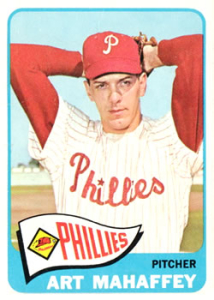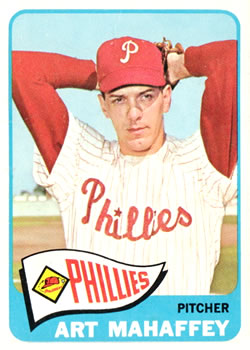April 23, 1961: Phillies’ Art Mahaffey fans franchise record 17 batters
 Part of the beauty of baseball is just how unpredictable the national pastime really is. No matter what the standings show, or what the prospects for a particular team are, on any given day at the ballpark, there is a chance that you might see something you’ve never seen before.
Part of the beauty of baseball is just how unpredictable the national pastime really is. No matter what the standings show, or what the prospects for a particular team are, on any given day at the ballpark, there is a chance that you might see something you’ve never seen before.
That was certainly the case when the Philadelphia Phillies hosted the Chicago Cubs on a sunny Sunday at Connie Mack Stadium early in the 1961 season. There was no reason to expect anything spectacular. Long before sabermetrics became part of baseball jargon and thinking, the April 23 doubleheader that pitted the second-place Chicago Cubs (5-4) against the eighth-place Phillies (2-7) didn’t appear to be what would ultimately be a memorable day of baseball. But the game is played on the field and the 16,027 fans who turned out saw a day at the ballpark for the ages.
In the opener, veteran Frank Sullivan outdueled young Cubs left-hander Dick Ellsworth, 1-0. Phillies left fielder Bobby Gene Smith smashed a home run to left field to lead of the home half of the ninth inning, ending the game with what would later be called a walk-off home run. But the real fireworks were about to explode in the nightcap. Not because the Phillies handily beat the Cubs, 6-0, but because the Phillies fireballing right-hander Art Mahaffey fanned 17 Cubs in the process, a new team record. The Cubs and their starter, Bob Anderson, weren’t able to put up much of a fight in the record-setting game.
Adding to the improbability of Mahaffey doing anything special that day was the fact that his second start of the season had been delayed a few days after he strained his back running on the previous Tuesday. If other pitchers could be guaranteed the same results, many might have tried to strain their backs as well.
The 23-year-old Mahaffey had electric stuff highlighted by a fastball in the high 90s and a curve that looked as though it could roll off a table, both delivered from a deceptive herky-jerky motion making the hitter’s task even more difficult. The game started normally enough. With one out in the top of the first inning, Mahaffey struck out Don Zimmer and Bob Will. They were the first two of what was to be a 17-strikeout performance in a nine-inning game – a Phillies record that still stood in 2020. He blew away the previous Phillies mark of 13 strikeouts held by Earl Moore (September 12, 1910), Ray Benge (June 16, 1929), Robin Roberts (May 2, 1957), and Jack Sanford (June 7, 1957). Ironically, the opponent in all three of those games was also the Cubs.
Long before pitch counts were relevant in baseball, Mahaffey would throw 146 pitches that day, 98 for strikes. And he could not be accused of bottom feeding, as he fanned future Hall of Famer Ernie Banks as well as Ron Santo, Zimmer, and Frank Thomas each three times. The only starters who did not strike out that day were center fielder Al Heist and first baseman Ed Bouchee.
Mahaffey stuck out at least one Cub in every inning, fanning the side in the second and sixth innings, and punching out two hitters in four frames. Clearly, his strained back was not an issue.
“I never thought about it,” he told Philadelphia Inquirer sportswriter Allen Lewis. “I wasn’t trying to pace myself. I was just trying to get them out. I tired a little around the fifth, but then I got my second wind.”1
Pitching coach Bob Lemon had a tongue-in-cheek comment. “This ruins all my theories about pitching,” he said. “Mahaffey did what he did with a bad back and without doing any running. Funny game, isn’t it?”2
Phillies hitters wasted little time in giving Mahaffey offensive support, scoring single runs in each of the first two innings. Then in the home half of the fifth inning, Ruben Amaro Sr. led off with a triple. After two infield outs, Anderson walked Tony Taylor. Right fielder Johnny Callison followed with a three-run homer, giving Mahaffey a five-run cushion. By that time, he had amassed 10 strikeouts.
The Phillies were destined to finish in the cellar in the National League with a 47-107 record, 46 games behind the Cincinnati Reds. They would lose 23 straight games from July 29 to the first game of a doubleheader on August 20, the most in the major leagues since 1900.
Mahaffey led the staff with 11 wins and 19 losses with a 4.10 ERA. He also was the leader with 12 complete games, three shutouts, 219⅓ innings pitched and 158 strikeouts. Other starters included Sullivan (3-16), John Buzhardt (6-18), Chris Short (6-12), Robin Roberts (1-10), Don Ferrarese (5-12), and Jim Owens (5-10). The staff as a whole finished last in the league in wins (47), ERA (4.61), complete games (29), earned runs (708), and saves (13).3
But still, Mahaffey was an All-Star in 1961 and 1962. In addition to his difficult pitching motion, he also had an outstanding move to first base. He picked off the first three players who got hits against him, Curt Flood and Bill White of the St. Louis Cardinals on July 30, 1960, followed by Jim Marshall of the San Francisco Giants on August 3, 1960.
Against the Cubs, there weren’t many opportunities to pick runners off base: Mahaffey scattered four hits and walked just one batter. For most of the game he used all of his pitches, but as the game progressed, he began to concentrate more on his fastball.
“I threw mostly fastballs, particularly in the late innings,” he said. “It was working so well, I just kept throwing it. In the last few innings, I didn’t throw more than a couple of curves. Earlier, I got maybe five or six strikeouts with my curveball.”4
Mahaffey continued to cruise through the Cubs lineup with 15 strikeouts through seven innings. The Phillies added one more run in the eighth. Taylor greeted reliever Dick Drott with a single to left. After Callison fanned, Bobby Gene Smith advanced Taylor to second base with a groundout, and Taylor scored on a single by Tony Gonzalez, upping the Phillies’ lead to 6-0.
Mahaffey struck out only one Cub in each of the last two innings. Zimmer was his final victim, leading off the top of the ninth inning. Bob Will followed with a single up the middle. Santo flied out to Smith in left field for the second out. While Mahaffey concentrated on getting Banks to be the final out of the game, Will moved to second and base on consecutive calls of defensive indifference, but to no avail, as Banks popped out to Taylor at second base to end the gem.
“Maybe that extra rest helped,” Phillies manager Gene Mauch said. “That was the most powerfully pitched game I ever saw and I’ve been in baseball for 20 years.”5
Mahaffey fell one whiff short of the major-league record at the time of 18 strikeouts in a nine-inning game held by Bob Feller of the Cleveland Indians in 1938 and Sandy Koufax of the Los Angeles Dodgers in 1959.6
“I had two strikes on the last four batters, but only got one strikeout,” he said years later. “I came close to having more than 17. With some of the starters the Phillies have had, it’s a wonder that it hasn’t been broken.”7
Four Phillies pitchers have come within one strikeout of tying Mahaffey’s record: Steve Carlton on June 9, 1982, against the Cubs; Curt Schilling on September 1, 1997, against the New York Yankees; Cliff Lee on May 6, 2011, against the Atlanta Braves, and Vince Velasquez on April 14, 2016, against the San Diego Padres.
Mahaffey once again led the Phillies in victories in 1962 with a 19-14 record, but then shoulder miseries began to nag him and limit his effectiveness. He was 7-10 in 1963 and 12-9 with the ill-fated ’64 team. He was a disappointing 2-5 in 1965 and was traded after the season to the St. Louis Cardinals with catcher Pat Corrales and outfielder Alex Johnson for shortstop Dick Groat, catcher Bob Uecker, and first baseman Bill White. His career ended after he went 1-4 for St. Louis in 1966. His career mark was 59-64.
Mahaffey was invited to Citizens Bank Park in Philadelphia on April 20, 2011, to commemorate the 50th anniversary of his 17-strikeout performance by throwing out the first pitch prior to the Phillies game against the Milwaukee Brewers. He threw a perfect strike at the knees.8
SOURCES
In addition to the sources cited in the Notes, the author accessed Retrosheet.org, Baseball-Reference.com, and SABR.org.
NOTES
1 Allen Lewis, “Winning Counted, Not That Record,” Philadelphia Inquirer, April 21, 1961.
2 Lewis.
3 John Thorn and Pete Palmer, eds., Total Baseball: The Ultimate Encyclopedia of Baseball, Third Edition (New York: HarperCollins Publishers, 1993).
4 Lewis.
5 Lewis.
6 As of 2020, the record of 18 strikeouts has been eclipsed by Roger Clemens of the Boston Red Sox, Max Scherzer of the Washington Nationals, Randy Johnson of the Arizona Diamondbacks, and Kerry Wood of the Cubs, who all fanned 20 hitters.
7 Larry Shenk, “Mahaffey’s 17-Strikeout Gem Stands the Test of Time,” mlb.com/news, December 17, 2015.
8 Ralph Berger and Mel Marmer, Art Mahaffey, SABR BioProject, sabr.org.
Additional Stats
Philadelphia Phillies 6
Chicago Cubs 0
Game 2, DH
Connie Mack Stadium
Philadelphia, PA
Box Score + PBP:
Corrections? Additions?
If you can help us improve this game story, contact us.


